‘Monuments are full of wisdom, for they have been filled with what they have seen and heard for hundreds of years!’
We are incredibly lucky on The Suffolk Coast to have hundreds of public works of art, a well as important monuments in our towns and villages. Sometimes loathed, often cherished, sometimes imposing, occasionally unusual, they all have their own story to tell and provide curiosity and interest for locals and visitors alike.
Find out about some of the intriguing statues dotted along The Suffolk Coast and look out for them when you're able to visit our stunning shores once more...
Maggi Hambling's 'Scallop' on Aldeburgh beach
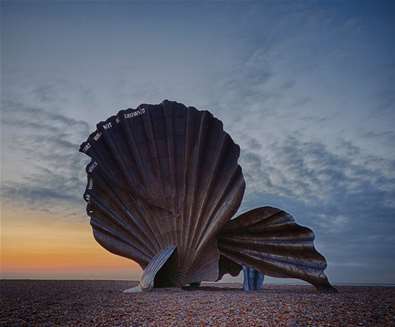
This iconic sculpture by Suffolk born artist Maggi Hambling is a striking sight on pebbly Aldeburgh beach. At four metres high and made out of steel, it’s hard to ignore the light shining off the two interlocking scallop shells on a sunny day.
Originally conceived as a tribute to famous local composer Benjamin Britten, the sculpture displays a quote from Britten’s Peter Grimes: ‘I hear those voices that will not be drowned’. It has been suggested that this sculpture is a piece of audio art as well as a visual one; fittingly, the shape of the shell is like an ear and perhaps amplifies the crashing of the waves. You’ll be instantly drawn towards this arresting piece.
‘Snooks’ Aldeburgh
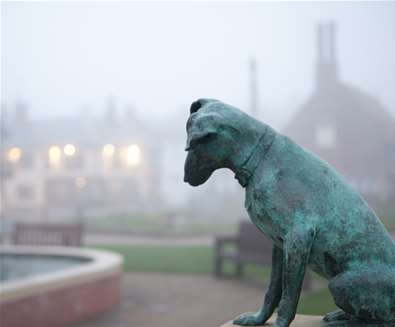
The charming bronze figure of a dog sits on a stone plinth on Aldeburgh sea front overlooking the boating lake. With her head cocked to one side, it is almost as if Snooks, as the local call her, is watching the model yachts on the boating lake. Look closely at the inscription on her collar, and you’ll find Snooks’s full name is Mrs Snooks Chip Winkler. Snooks was the canine companion of two local doctors, Robin and Nora Acheson, who served the residents of the town from 1931. Following Dr Robin’s death in 1959 the community commissioned this memorial, created by Gwynneth Holt. When Dr Nora died in 1981, her name was added to the inscription.
Tragedy stuck in 2003 when the statue was stolen and after much fundraising a replica was created and put in the original’s place. To everyone’s surprise, the original Snooks was found in 2012 at an antiques fayre and was returned to the town. The original Snooks now delights visitors in the garden of Aldeburgh Community Hospital.
'Family of Man' Snape Maltings
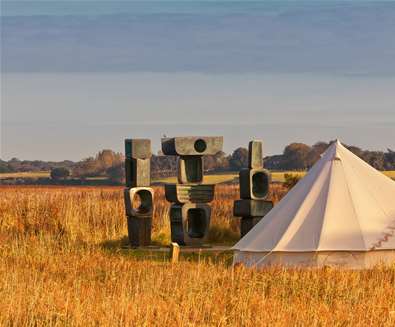
This evocative sculpture by Barbara Hepworth was created in the early 1970s and was unfinished at the time of the artist’s death. It is interesting to note that although two sets of the sculpture were created, the only complete set is located in the Yorkshire Sculpture Park.
The parts that can be seen nestling close to the reed beds at Snape Maltings are a smaller selection of the group of pieces that form the whole ‘family’; a group of nine bronze sculptures, which can be displayed individually, in small groups or all together, with each structure representing a stage of human life. The bronzes resemble piled up stones that somehow suggest human figures. The artist said that she wanted the forms to look as if they had ‘risen out of the ground’ almost like natural formations or rocks.
'The Tritons' Lowestoft Seafront
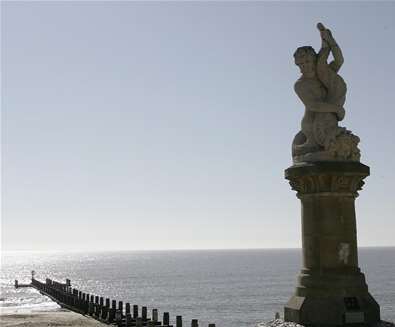
Stroll far enough down the seafront at Lowestoft and you will find not one but two almost identical statues depicting, aptly, the Greek God of the sea Triton. Although quite eroded by the harsh winds and salty spray these statues still maintain their original mythological charm. They were originally commissioned by Sir Samuel Morton Peto, an entrepreneur and engineer who famously redeveloped many buildings in Lowestoft and created railway lines to Norwich and Ipswich.
The sculptor, John Thomas, created a pair of Tritons to mark the development of the new esplanade. Each one has their back to the sea and faces the town carrying a cornucopia to represent the prosperity that Peto brought to Lowestoft. If you look carefully you might be able to see the decorative dolphin heads around the base.
'The Giles Statue' Ipswich
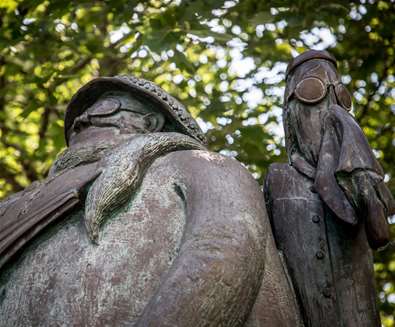
If you visit Ipswich you might just spot a very unusual bronze statue. In fact you can’t miss it! Carl Giles gained fame as an illustrator and cartoonist, worked for the daily express and received an OBE for his topical and highly detailed works.
He lived in Tuddenham near Ipswich and ‘the Grandma statue’ stands in the town centre in his honour. This depiction of one of Giles’s most beloved characters is surrounded by other characters that he became so well-known for. See if you can spot the twins Laurence and Ralph and Rush the dog. Grandma herself is gazing up toward the Studio window of what was once Giles’s office. These days you are likely to find many people sat around its base, pausing for lunch or to take a phone call.
'The Mechanical Water Clock' Southwold Pier
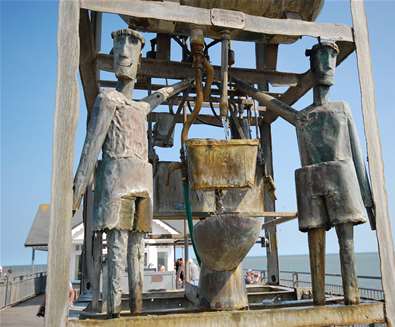
Brussels is well known for its humorous Manneken Pis but Southwold Pier has a sculpture that might well rival it. Stroll along the elegant pier and you will soon reach a rather eccentric structure; the mechanical water clock. Every half an hour the water that has been pumped to the top of the clock powers a rather *ahem* cheeky performance. The two characters’ pants will drop and they will piddle punctually.
Tim Hunkin and Will Jackson made this unusual sculpture in 1988, in the space of just three weeks. It was actually created to convey a message about recycling and all of the copper used to make it was salvaged from old hot water cylinders.
'Drummer Boy' Woodbridge
Though its official name is ‘The Drums of Fore and Aft’, this sculpture is affectionately known by locals as ‘The Drummer Boy’. It stood for three decades outside of the former headquarters of Suffolk Coastal District Council in Woodbridge and was removed for renovation following quite a debate over its ownership and rightful whereabouts. But now the cherished piece stands happily on Market Hill having received some much needed TLC, returning it to its former glory.The statute itself is said to have been inspired by Kipling’s story of a disastrous battle in the Anglo-Afghan war. Many locals gathered to see the statue unveiled in its new location in 2018 and are elated to have it back in pride of place.
‘Southwold Jack’ St Edmund’s Church, Southwold
The church of Saint Edmund is home to an iconic figure who has become quite famous throughout Southwold. ‘Southwold Jack’ is a fifteenth century clock jack that has been repurposed to ring a bell. The wooden figures stands just under 4.5 foot tall and is dressed like a solder from the War of the Roses, clutching a sword and battle axe in his hands. Any brides lucky enough to be married at this church have their arrival signalled by Southwold Jack, swinging his axe and striking the bell.
In the early twentieth century local Adnams brewery decided to ‘borrow’ Southwold Jack for its trademark beer. Now you will see little replicas on the front of the Adnams Brewery building and many Adnams pubs have some form of Southwold Jack on their walls. Southwold Jack has become so iconic that you can spot versions of him everywhere from door-knockers to fridge magnets, but to view the original Jack you’ll have to pop into St Edmund’s Church and look up.